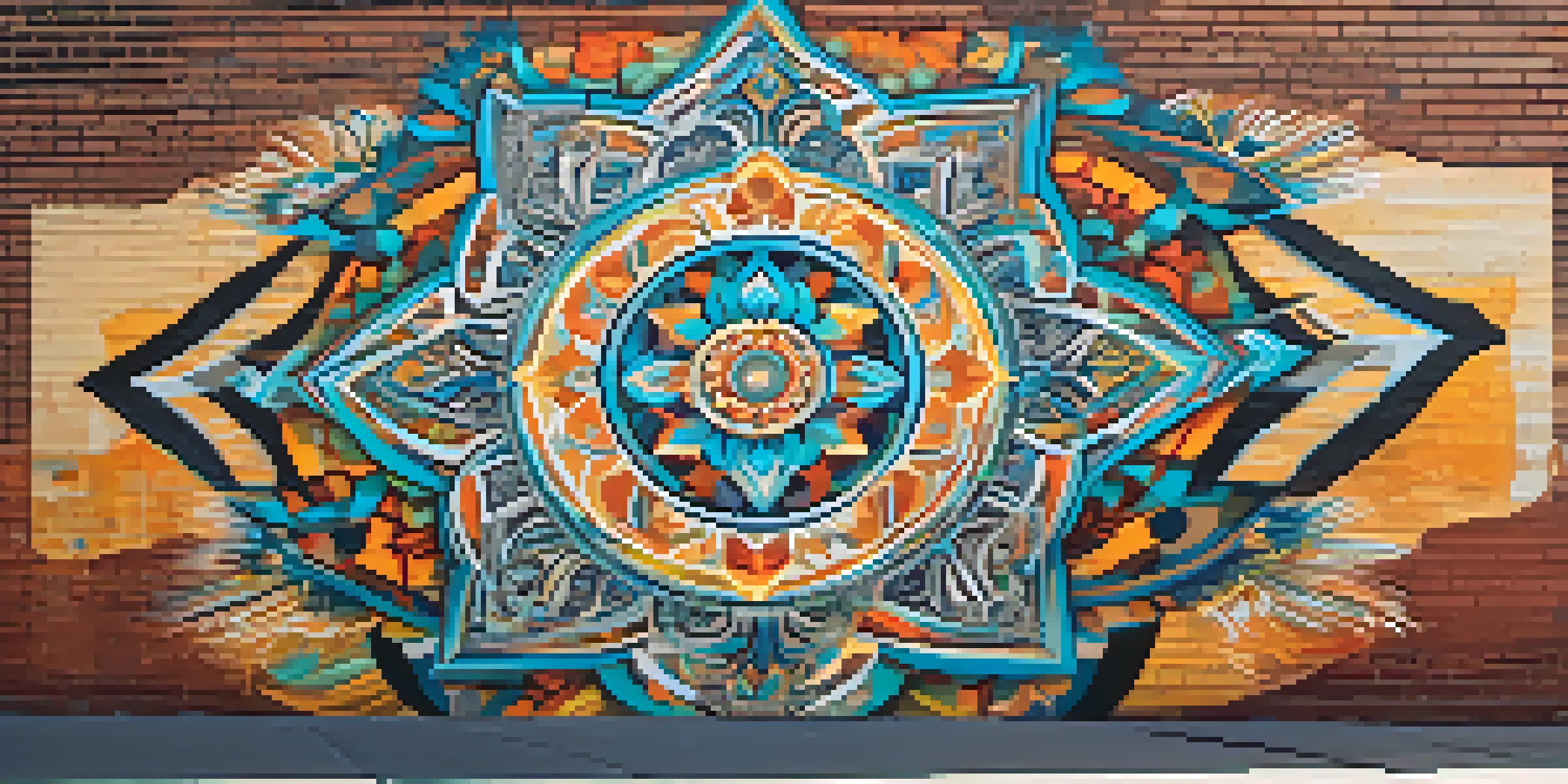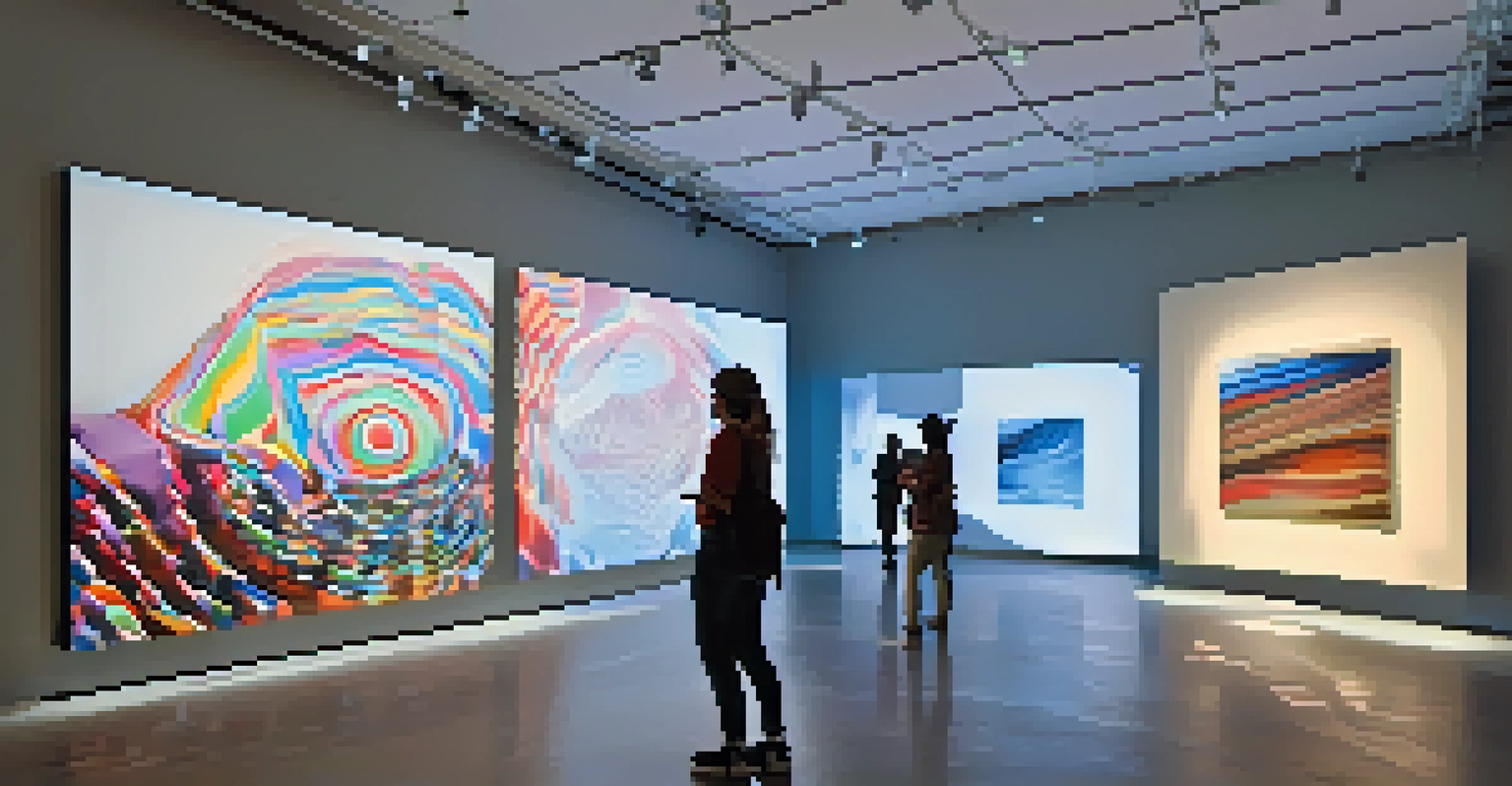The Influence of Culture on Art Theory and Practices

Understanding Culture's Role in Art Creation
Culture serves as the backbone of artistic expression, influencing everything from themes to techniques. Artists often draw from their cultural backgrounds, embedding personal and communal narratives into their work. For instance, Indigenous artists may incorporate traditional symbols and storytelling methods, making their art a reflection of their heritage and identity.
Art is not a mirror held up to reality but a hammer with which to shape it.
Moreover, cultural contexts can determine what materials and styles are accessible or preferred by artists. In some cultures, specific colors or motifs hold significant meaning, guiding the artist in their creative choices. This interplay between culture and art demonstrates how deeply intertwined they are, shaping not just individual pieces but entire movements.
Related Resource
As we examine the creation of art through a cultural lens, we begin to see how diversity enriches the artistic landscape. Different cultures contribute unique perspectives, leading to innovative practices that challenge conventional norms. This dynamic exchange cultivates a richer understanding of art as a universal language.
Cultural Movements and Their Artistic Impact
Throughout history, cultural movements have sparked significant shifts in artistic practices. Take the Renaissance, for example: emerging from a renewed interest in classical antiquity, it fostered a surge of creativity that emphasized realism and human emotion. Artists like Leonardo da Vinci and Michelangelo pushed boundaries, inspiring future generations to explore new techniques.

Similarly, the Harlem Renaissance marked a pivotal moment in American art, highlighting the contributions of African American artists and writers. This cultural revival not only celebrated Black identity but also challenged societal norms, leading to a broader appreciation of diverse artistic expressions. The impact of such movements can be felt even today, as they continue to influence contemporary art.
Culture Shapes Artistic Expression
Cultural backgrounds influence artists' themes and techniques, enriching their work with personal and communal narratives.
These cultural currents remind us that art is not created in a vacuum; it is a response to the world around us. By understanding the historical context of artistic movements, we gain insight into how culture shapes not just the art itself, but also the artists' motivations and audiences' interpretations.
The Role of Cultural Identity in Artistic Expression
Cultural identity plays a crucial role in how artists express themselves and connect with their audiences. For many, art becomes a personal journey of exploring their roots and sharing their stories. An artist from a marginalized community, for example, might use their work to bring attention to social issues, creating a dialogue that resonates on a deeper level.
Culture is the widening of the mind and of the spirit.
This exploration of identity often leads to a rich tapestry of styles and themes, as artists draw from their diverse experiences. The fusion of different cultural elements can result in groundbreaking works that defy categorization. Think of how hip-hop culture has influenced visual art, merging music, dance, and graffiti into a dynamic form of expression.
Related Resource
Ultimately, the interplay between cultural identity and artistic expression fosters empathy and understanding. When viewers engage with art that reflects the artist's cultural background, they gain insight into different perspectives, enriching the collective human experience.
Tradition vs. Modernity in Art Practices
The tension between tradition and modernity is a recurring theme in the world of art. Many contemporary artists grapple with the desire to honor traditional practices while also pushing the boundaries of innovation. This dynamic can lead to exciting new forms, as artists blend age-old techniques with modern materials and ideas.
For instance, in many Asian cultures, traditional ink painting is being reinterpreted through digital mediums, creating a dialogue between past and present. Such adaptations not only keep the tradition alive but also make it relevant to new audiences. This fluidity illustrates how culture is not static; it evolves alongside society.
Art Reflects Societal Values
Art serves as a mirror of society, capturing its beliefs and challenges while provoking thought and inspiring change.
This ongoing negotiation between tradition and modernity highlights the adaptability of art. As artists navigate their cultural heritage and contemporary influences, they create a rich dialogue that reflects the complexities of modern life. In this way, art becomes a living testament to our ever-changing cultural landscape.
Globalization's Influence on Artistic Practices
In today's interconnected world, globalization has significantly impacted art and culture. Artists can now access a wealth of influences from around the globe, leading to a cross-pollination of ideas, styles, and techniques. This phenomenon can be seen in the rise of street art, where local artists incorporate global themes and motifs into their work.
However, this blending of cultures can also raise questions about authenticity and cultural appropriation. As artists borrow elements from different traditions, it's essential to navigate these waters with respect and understanding. The conversation around cultural ownership reminds us of the importance of honoring the origins of artistic practices.
Related Resource
Globalization, therefore, presents both opportunities and challenges for artists. While it enriches the artistic landscape by fostering diversity, it also necessitates a thoughtful approach to cultural exchange. By engaging in this dialogue, artists can create works that celebrate shared humanity while respecting individual cultural identities.
The Impact of Technology on Art and Culture
Technology has revolutionized the way we create and experience art, acting as both a tool and a medium. Digital art, for example, allows artists to explore new dimensions, from virtual reality to interactive installations. This shift not only expands the possibilities of artistic expression but also influences how audiences engage with art.
Social media platforms have further transformed the art world, providing a space for emerging artists to showcase their work to a global audience. This democratization of art has led to diverse voices being amplified, reflecting a broader range of cultural perspectives. Artists can now connect with fans and fellow creatives, fostering a sense of community that transcends geographical boundaries.
Tradition Meets Modern Innovation
Contemporary artists blend traditional practices with modern techniques, creating dynamic works that reflect the evolving cultural landscape.
However, the integration of technology also prompts discussions about the nature of art itself. As we navigate this evolving landscape, it becomes crucial to consider how technology shapes our understanding of culture and creativity. The intersection of art and technology offers exciting possibilities, inviting us to reimagine the future of artistic practices.
Art as a Reflection of Societal Values and Beliefs
Art has long served as a mirror of society, reflecting its values, beliefs, and challenges. From political propaganda to social commentary, artists have utilized their platforms to provoke thought and inspire change. For instance, the works of artists like Banksy challenge societal norms, sparking conversations about issues such as inequality and consumerism.
Moreover, art can capture the zeitgeist of a particular era, offering insight into the collective consciousness of a culture. Whether it’s the bold colors of the Fauves or the somber tones of Post-Impressionism, each movement tells a story about the time and place in which it was created. This connection between art and societal values underscores the importance of understanding context.

By examining art through the lens of culture, we can better appreciate its role in shaping and reflecting societal narratives. As we engage with various forms of artistic expression, we uncover the layers of meaning that resonate within our communities, sparking dialogue and fostering understanding.